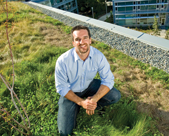Going with the flow
Mimicking Mother Nature may help us ward off floods caused by climate change

UVic’s Social Sciences and
Mathematics Building
By Peigi McGillivray
If climate change means more extreme rainfall, as scientists predict, how should we prepare to cope with all the extra water? Should we be installing larger storm water pipes? Diverting streams? Stockpiling sandbags?
Chris Jensen, a master’s student in geography at the University of Victoria, thinks there’s a better way. He’s investigating how to manage rainwater where it falls—on individual buildings, streets, gardens and subdivisions —rather than directing it into storm water systems buried under city streets.
“If rainwater is absorbed where it falls, there’ll be less risk of overloading our storm water systems and less flood damage to homes, businesses and sensitive aquatic habitats,” he says. “It’s a gentler, more natural way of managing rainfall.”
Funded in part by a graduate fellowship from the UVic-led Pacific Institute for Climate Solutions, Jensen is using sophisticated computer models to assess the ability of various low-impact development strategies to cope with rainwater.
His study site is the heavily urbanized Bowker Creek watershed, which straddles the municipalities of Victoria, Oak Bay and Saanich.
“Bowker Creek is an ideal case study,” he says. “About 50 per cent of its surface is impermeable due to roads, buildings and pavement and a recent study led by the Capital Regional District predicts that there will be increased flooding there in the future.”
Low-impact development strategies include permeable paving materials, green roofs and rain gardens. “The idea is that if we can use some combination of these,” says Jensen, “we can reduce flooding without expensive upgrades to the existing drainage infrastructure.“
Permeable paving includes paving stones as well as special porous concrete and asphalt that could be used on driveways and patios, and on complete road systems, he says. These surfaces allow rainwater to soak into the ground naturally.
Green roofs are designed to support soil and plants. Some are able to reduce peak runoff by up to 75 per cent. “When you look at an aerial view of any city you can see how much potential roofs offer for absorbing rainwater and slowing runoff,” says Jensen.
Rain gardens are sunken green spaces where ponds can form after a heavy rain. They can be placed in people’s yards and along the sides of roads, where they help filter pollutants and keep rain out of the storm water system.
“Theoretically, these treatments can absorb the increase in precipitation, thereby eliminating the need for costly engineering solutions,” says Jensen. Upgrading the watershed’s drainage systems could cost as much as $10 million.
Jensen has been involved with the Friends of Bowker Creek Society since 2001. He’s also worked extensively with municipal officials, engineering consultants, watershed societies and provincial staff to overcome the regulatory, policy and technical challenges of low-impact development.
“This is really a ‘no regrets’ way to prepare for possible flooding,” he says. “If climate change doesn’t produce the extreme rainfall predicted, rain gardens, green roofs and permeable pavements will still make our neighbourhoods greener and more pleasant, create and protect natural habitats, and improve the health of urban watersheds.
“Because this is the first climate change adaptation study of its kind, we have a chance to show the world how small changes can make a big difference to our cities.”
View as PDF (300K).
- To find out which low-impact development strategy might be best for your property, visit http://www.waterbalance.ca. This award-winning rainfall-runoff modeling tool can help you decide.
- Almost 90 per cent of the Bowker Creek watershed has been developed for commercial, industrial, institutional and residential use. Seventy per cent of the creek’s original channel is now confined to culverts, which form the backbone of municipal storm water drainage systems.
- The Pacific Institute for Climate Solutions (PICS), led and hosted by UVic, is a collaboration of BC’s four research-intensive universities. Its mandate is to understand the patterns and magnitude of climate change; evaluate the physical, economic and social implications; assess options and develop innovative solutions; and communicate climate change issues to government, industry and the public.
- UVic researchers were awarded more than $104 million in outside research grants and contracts in 2008/09—more than double the research support of five years ago.
